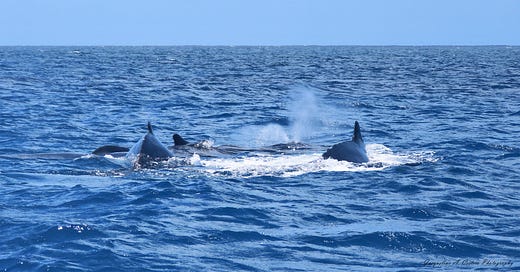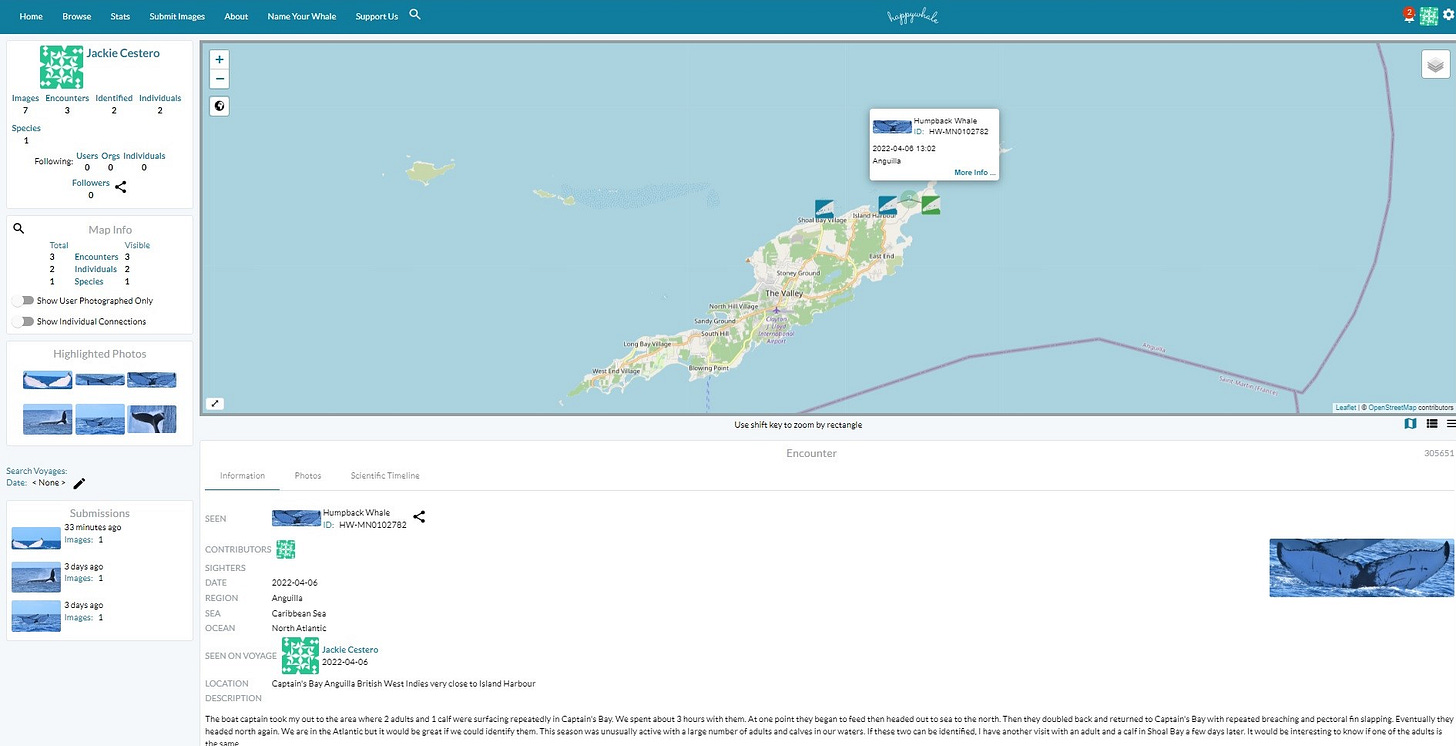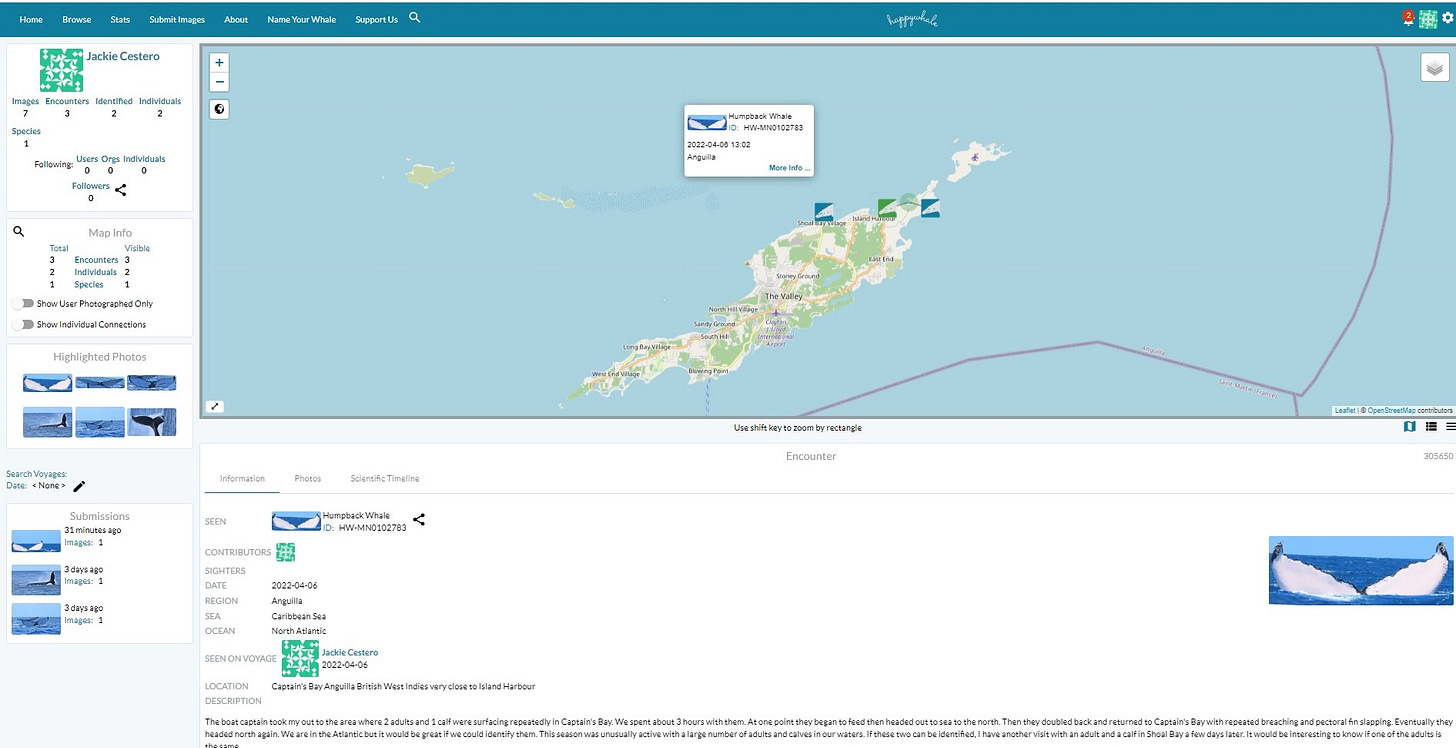After our exciting report on the Humback Whale family in April of 2022, I couldn’t help but wonder if there was a way to identify the adults in the family through their tails.
As you may recall from that post, each Humpback Whale is identifiable by its tail. It is the equivalent of a human fingerprint.
I set out to find organizations that identify whale tails. Many are regional and are meant to keep track of the individuals seen in a certain area over time.
My research led me to a more global group called Happy Whale, that uses “state-of-the-art image processing algorithms to match whale photos with scientific collections.” It is citizen science for whales!
The statistics for Happy Whale show that they have identified over 79,000 individuals through more that 192,000 reports and close to a half a million photographs.
Reporting marine mammal information is not so different from the banded bird sightings that we report on a regular basis. The goals are similar as you can see from Happy Whale’s “About” page. However, a variety of body parts are used to identify different species of marine mammals, instead of a band or flag.
Why collect marine mammal photos and sighting data? Sighting data, especially when paired with the recognition of individual animals through photo ID, can be extremely powerful for studies of population, status and changes. Photo ID is a technique with history, a non-invasive tool first applied to humpback whales in the 1970s by Katona and Jurasz, who saw the persistent patterns and shapes in humpback whale tails that allowed tracking over time. Since then the technique has been applied to many whale and dolphin species, using different body parts including tails for humpbacks and sperm whales, dorsal fins for many species of whales and dolphins, patterns on the flanks of blue and grey whales, head patterns in right whales, and even facial recognition in bottlenose dolphins. Through study of multiple sightings of individuals over time and space, scientists can learn about migratory patterns and home ranges, model population growth or decline, and even estimate the survival rate of individuals in a population.
A simple process allows you to create an account and upload whale tail photos. You provide the GPS coordinates where the individual was seen and a brief description of the encounter. The site creates a record for each individual and assigns an identification number for new individuals. It also lets you know if it is an individual that has already been identified.
I was able to get very clear photos of the two adults and both were uploaded to the site. Both whales were new to the database and have been assigned ID numbers.
The first record is for the scarred tail individual, most likely the male (HW-MN0102782). Honestly, I find this number a bit impersonal. Therefore, I will call him “Captain” for the location we found the family.
The second is the record of the whale with the least amount of scarring on the tail. I believe based on size, this is the female (HW-MN0102783). I named her “Scrub” because I am sure they visited the waters of that nearby cay while they were here.
Of course that means the calf has to be called “Little Scrub!”
They were not able to provide an ID for the Shoal Bay Humpback, because I did not have a clear photograph of the underside of the tail. That encounter was on April 10, 2022. So if anyone happens to have a photograph of the tail from that day, I can add it to the record. A clear photograph of the underside of that adult tail would allow Happy Whale to match it with the adults from the April 6, 2022 encounter. Their initial reaction to the photographs submitted was that it was a different individual.
With the two Captain’s Bay individuals in the Happy Whale databse, they will notify me if a match is made with another entry in the future. I imagine I will have a long wait, but wouldn’t it be great if it happened? Perhaps this family will return to our waters in the near future! Time will tell.
Have you had any close encounters with whales in Anguilla’s waters? What names would you give our Humpback Whale family? Please share your thoughts in the comments or via email!
Anguilla Tourism Survey Needs Your Feedback!
While I have your attention, the Anguilla Hotel and Tourism Association is conducting a survey and your input is vital to the process.
Just go to www.anguillatourismsurvey.com and share your thoughts about your last stay and what we can do more or change, to welcome you back soon!
We always love your feedback on the islands natural resources in addition to our amazing beaches and food offerings.
If you see the signs in either of the departure lounges, just scan the QR code and go straight to the survey. You can fill it out while you wait!
Many thanks in advance.









